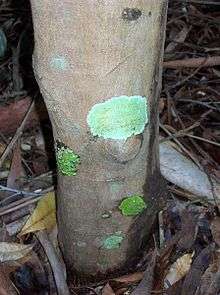Acronychia pubescens
Acronychia pubescens is a rainforest plant in the citrus family, growing in eastern Australia.[1] Common names include Hairy Aspen and Hairy Acronychia.[2]
| Hairy Aspen | |
|---|---|
 | |
| Scientific classification | |
| Kingdom: | |
| (unranked): | |
| (unranked): | |
| (unranked): | |
| Order: | |
| Family: | |
| Genus: | |
| Species: | A. pubescens |
| Binomial name | |
| Acronychia pubescens | |
| Synonyms | |
| |
Description
Acronychia pubescens grows as a small tree up to 15 metres (50 ft) in height and with a stem diameter of 18 cm (7 in). The trunk is mostly cylindrical, but occasionally with flanges at the base. Bark is greyish brown and relatively smooth. Small branchlets are downy, of a golden colour. Leaf scars easily noticed.[3]
The leaves usually form in threes, occasionally in ones or twos. The compound leaves are arranged oppositely on the stem. The leaf stem is between 0.8 and 8 cm long. Leaflets are 5.5 to 22 cm long and 1.8 to 7.7 cm wide, without leaf stems. They are lanceolate in shape, with a blunt point, though occasionally the point will be sharper; the top surface of the leaflets is downy, particularly along the mid-rib, but they are hairier under the leaf. Oil dots are not visible. Leaf veins easily noticed, particularly under the leaf. The mid-rib is usually sunken on the top side, and all veins raised under the leaf. The greenish fawn flowers form from March to June in lateral or axillary cymes. The cymes are around 25 cm (10 in) long, and individual flowers are hairy and 8 mm long.[3] The hairy leaves distinguish them from other members of the genus.[4]
The fruit matures from January to March, but ripe fruit may also be found in all months. The fruit is hairy, fleshy and ridged, a yellow drupe, 2.5 cm (1 in) in diameter, with an acid or turpentine flavour. There are one to three seeds per fruit. Seeds are a dark grey or black, with a shape resembling a miniature canoe. Removal of the flesh from the seed is advised for regeneration. Around a half of the seeds may germinate in seven months. Cuttings may also be attempted.[3]
Taxonomy
Commonly known as the hairy aspen or hairy acronychia, the species was first described as Melicope pubescens by Frederick Manson Bailey in 1891 after a collection from the Blackall Range.[5] It gained its current binomial name in 1939 when reclassified by his grandson, Queensland Government Botanist Cyril Tenison White.[6] The specific epithet pubescens means hairy, referring to the downy leaves.[3]
Distribution and habitat
It ranges from Urunga in northern New South Wales to the Blackall Range in south eastern Queensland. The habitat is of several rainforest types; including subtropical rainforest on red/brown basaltic soils, littoral rainforest and riverine rainforest. Most often seen in warm temperate rainforest at higher altitudes.[3]
Cultivation
Acronychia pubescens requires good drainage, but benefits from extra water and fertiliser when grown in cultivation. Although its fruits are edible, their turpentine taste detracts somewhat from their palatability.[4]
References
- "Acronychia pubescens". PlantNET - NSW Flora Online. Retrieved 2010-11-24.
- "Australian plant common name database". Australian National Botanic Gardens. Archived from the original on 16 November 2010. Retrieved 2010-11-30.
- Floyd, A.G., Rainforest Trees of Mainland South-eastern Australia, Inkata Press 2008, ISBN 978-0-9589436-7-3 page 348
- Elliot, Rodger W.; Jones, David L.; Blake, Trevor (1985). Encyclopaedia of Australian Plants Suitable for Cultivation: Vol. 2. Port Melbourne: Lothian Press. p. 143. ISBN 0-85091-143-5.
- "Melicope pubescens F.M.Bailey". Australian Plant Name Index (APNI), IBIS database. Centre for Plant Biodiversity Research, Australian Government.
- "Acronychia pubescens (F.M.Bailey) C.T.White". Australian Plant Name Index (APNI), IBIS database. Centre for Plant Biodiversity Research, Australian Government.